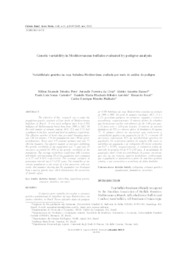Genetic variability in Mediterranean buffalos evaluated by pedigree analysis.
Genetic variability in Mediterranean buffalos evaluated by pedigree analysis.
Author(s): TEIXEIRA NETO, M. R.; CRUZ, J. F. da; RAMOS, A. A.; CARNEIRO, P. L. S.; AZEVEDO, D. M. M. R.; BOZZI, R.; MALHADO, C. H. M.
Summary: The objective of this research was to study the population genetic structure of four herds of Mediterranean buffaloes in Brazil. It was used pedigree data from 6,588 buffaloes of Mediterranean breed born from 1980 to 2002. Of the total number of animals studied, 60.5, 15.3 and 2.1% had a pedigree in the first, second and third ascendancy, respectively. The effective number of herds that provided breeding males was 1.60 for parents, 1.16 for grandparents and 1.00 for greatgrandparents. There were 923 founder animals and only 71 effective founders. The effective number of ancestors explaining the genetic variability of the population was 71 and only 30 ancestors accounted for 50% of the genetic variability of the population. The average relatedness coefficient (AR) between individuals and inbreeding (F) of the population were estimated at 0.37 and 0.34% respectively. The average estimate of generation interval was 8.71±2.85 years. The variability of the current population is the result of a few ancestors, who are mostly also founders showing that the population was developed from a narrow genetic base which characterizes the occurrence of founder effect.
Publication year: 2012
Types of publication: Journal article
Unit: Embrapa Mid-North
Observation
Some of Embrapa's publications are published as ePub files. To read them, use or download one of the following free software options to your computer or mobile device. Android: Google Play Books; IOS: iBooks; Windows and Linux: Calibre.
Access other publications
Access the Agricultural Research Database (BDPA) to consult Embrapa's full library collection and records.
Visit Embrapa Bookstore to purchase books and other publications sold by Embrapa.

